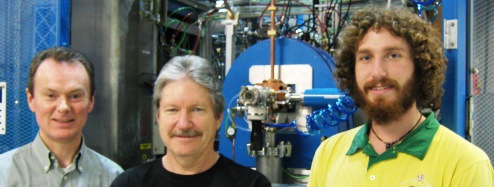
On December 2, 2008, a team of scientists, engineers, and technicians, led by Dr. Keerthi Jayamanna, first accelerated a multi-charge stable ion beam of Ar7+ from the OLIS (“Off Line Ion Source”) facility through the ISAC acceleration system.
Historically, the OLIS facility has provided stable (non-radioactive) ion beams from a microwave ion source or a surface ion source. These beams have been used directly for experiments, and for ‘pilot’ beams used in the setup of the rare isotope radioactive ion beams which are routinely delivered to experiments in ISAC. Electric charge is a key aspect of being able to produce and accelerate these ion beams. Up to now, beams from OLIS have mostly consisted of singly-charged ions, and a small number of doubly-charged ion beams have been developed.
Even doubly charge ion beams present a significant limitation due to the nature of the primary accelerating device in ISAC, the radio-frequency quadrupole or RFQ. Being a constant-velocity accelerating structure, the RFQ can only accelerate beams with a limited to a mass-to-charge ratio (less than 2keV/u), and accepts beam only up to 60keV in energy. This means that, for singly charged ion beams from OLIS, the heaviest element which could be accelerated was about mass 30 (silicon), or for doubly-charged ions, about 60 (nickel). This isn’t even half way through the Periodic Table of the Elements! Thus to study the interesting heavier elements, the ions in the beam would have to be charged to higher ionization states (i.e., more electrons must be removed from each atom/ion in the beam).
Now a new multi-charge “Supernanogan” ion source has come to the rescue, and has been incorporated into the OLIS facility with the capability of producing multi-charged ion beams of any known element. With Supernanogan, TRIUMF has the capability to produce multi-charged ion beams of +6 or more, and this makes it is possible to accelerate any stable element through the ISAC accelerator system. This eliminates the need of the old technique where the beam was sent through a stripping foil to achieve high mass-to-charge ratios (by stripping off electrons). The use of stripping foils has proven problematic because it reduces the quality and amount of beam, and because the foils often fail, leading to unnecessary downtime for experiments. An additional advantage of Supernanogan is that it is ‘greener’; being an ECR source it requires less power.
More than a year of hard work has gone into integrating the new Supernanogan multi-charge ion source to the existing OLIS facility. The result is a single high-voltage ion source terminal that houses three complete ion sources, with the capability of providing ion beams from any of these and switching quickly among them. The modular design of the new multi-charge Supernanogan ion source assembly allows for its removal from the OLIS facility for development and maintenance, leaving the other two ion sources to continue operating normally providing beams of lighter elements. Outside the terminal, the Supernanogan vacuum system can be run in a standalone mode, thus not disturbing the good vacuum state attained from days of conditioning, an important consideration for reliable generation of these high charge states.
Thanks are extended to the project principals, notably Geoff Wight, and to staff and students from the ISIS and Controls Groups, who worked tirelessly to complete the project.
Banner photo from left to right : Damien Gallop, Geoff Wight, and Gabe Wiebe
Article by: Damien Gallop and Geoff Wight
Kaitlan Huckabone
TRIUMF's Communications Assistant
